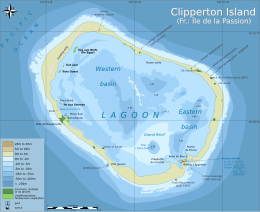
Back Clipperton Afrikaans جزيرة كليبرتون Arabic جزيرة كليبرتون ARZ Islla Clipperton AST Klipperton adası Azerbaijani Кліпертан Byelorussian Кліпэртан BE-X-OLD Клипертон Bulgarian Clipperton Breton Ostrvo Clipperton BS
Native name: La Passion–Clipperton (French) | |
|---|---|
 Clipperton Atoll with lagoon with depths (metres) | |
 Location of Clipperton Island | |
| Geography | |
| Location | Pacific Ocean |
| Coordinates | 10°18′N 109°13′W / 10.300°N 109.217°W[1] |
| Archipelago | Lagoon |
| Area | 8.9 km2 (3.4 sq mi)[2] |
| Length | 3 km (1.9 mi) |
| Width | 4 km (2.5 mi) |
| Coastline | 11.1 km (6.9 mi) |
| Highest elevation | 29 m (95 ft) |
| Highest point | Clipperton Rock |
| Administration | |
France | |
| State private property | Île de Clipperton |
| Demographics | |
| Population | 0 (1945) |
| Additional information | |
| Time zone | |
| Postal code | 98799[a] |
| |
Clipperton Island (French: La Passion–Clipperton [la pasjɔ̃ klipœʁtɔn]; Spanish: Isla de la Pasión), also known as Clipperton Atoll[5] and previously as Clipperton's Rock,[6] is an 8.9 km2 (3.4 sq mi) uninhabited French coral atoll in the eastern Pacific Ocean. The only French territory in the North Pacific, Clipperton is 10,675 km (6,633 mi) from Paris, France; 5,400 km (2,900 nmi) from Papeete, French Polynesia; and 1,280 km (690 nmi) from Acapulco, Mexico.
Clipperton was documented by French merchant-explorers in 1711 and formally claimed as part of the French protectorate of Tahiti in 1858. Despite this, American guano miners began working the island in the early 1890s. As interest in the island grew, Mexico asserted a claim to the island based upon Spanish records from the 1520s that may have identified the island. Mexico established a small military colony on the island in 1905, but during the Mexican Revolution contact with the mainland became infrequent, most of the colonists died, and lighthouse keeper Victoriano Álvarez instituted a short, brutal reign as "king" of the island. Eleven survivors were rescued in 1917 and Clipperton was abandoned.
The dispute between Mexico and France over Clipperton was taken to binding international arbitration in 1909. Victor Emmanuel III, King of Italy, was chosen as arbitrator and decided in 1931 that the island was French territory. Despite the ruling, Clipperton remained largely uninhabited until 1944 when the U.S. Navy established a weather station on the island to support its war efforts in the Pacific. France protested and as concerns about Japanese activity in the eastern Pacific waned the U.S. abandoned the site in late 1945.
Since the end of World War II, Clipperton has primarily been the site for scientific expeditions to study the island's wildlife and marine life, including its significant masked and brown booby colonies. It has also hosted climate scientists and amateur radio DX-peditions. Plans to develop the island for trade and tourism have been considered, but none have been enacted and the island remains mostly uninhabited with periodic visits from the French navy.
- ^ Findlay, A. G.; Maury, M. F. (1853). "Oceanic Currents, and Their Connection with the Proposed Central-America Canals". Journal of the Royal Geographical Society of London. 23: 217–242. doi:10.2307/1797966. JSTOR 1797966. Archived from the original on 1 April 2023. Retrieved 1 April 2023.
- ^ Jost, Christian H. (2003). "Clipperton – Île de la Passion: une aire française du Pacifique à protéger" [Clipperton – Île de la Passion: a French area in the Pacific to be protected]. In Lebigre, Jean-Michel; Decoudras, Pierre-Marie (eds.). Les aires protégées insulaires et littorales tropicales [Tropical island and coastal protected areas]. Îles et Archipels Nº32 (in French). Bordeaux: CRET. p. 244. ISBN 2-905081-45-7. OCLC 492187765.
- ^ Décret n° 2017-292 du 6 mars 2017 relatif au temps légal français [Decree No. 2017-292 of March 6, 2017 relating to French legal time] (Décret 2017-292) (in French). 6 March 2017. p. 2. Archived from the original on 8 March 2023. Retrieved 6 April 2023.
- ^ Jullien, Pierre (17 April 2020). "Clipperton : une " passion " américano-franco-mexicaine" [Clipperton: An American-Franco-Mexican "Passion"]. Le Monde (in French). Archived from the original on 31 July 2022. Retrieved 31 July 2022.
- ^ Glynn, P. W.; Veron, J. E. N.; Wellington, G. M. (June 1996). "Clipperton Atoll (eastern Pacific): oceanography, geomorphology, reef-building coral ecology and biogeography". Coral Reefs. 15 (2): 71–99. Bibcode:1996CorRe..15...71G. doi:10.1007/BF01771897. ISSN 0722-4028. S2CID 33353663. Archived from the original on 10 April 2023. Retrieved 3 April 2023.
- ^ Morrell, Benjamin (1841), A Narrative of Four Voyages to the South Sea, North and South, Pacific Ocean, Chinese Sea, Ethiopic and Southern Atlantic Ocean, Indian and Antarctic Ocean from the Years 1822 to 1831, New York, New York: Harper & Brothers, p. 219, archived from the original on 1 April 2023, retrieved 1 April 2023
Cite error: There are <ref group=lower-alpha> tags or {{efn}} templates on this page, but the references will not show without a {{reflist|group=lower-alpha}} template or {{notelist}} template (see the help page).
© MMXXIII Rich X Search. We shall prevail. All rights reserved. Rich X Search